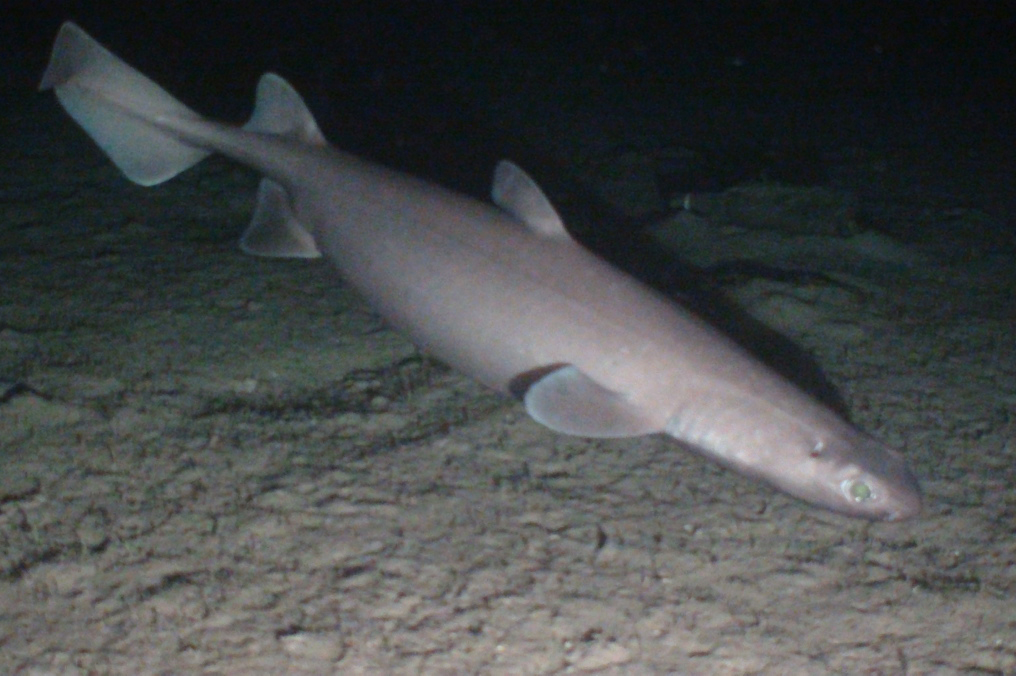Black Shark, Dalatias licha (Bonnaterre 1788)

A Black Shark, Dalatias licha, at Seco de los Olivos, Almería, Spain, June 2010. Source: Expedition Oceana Ranger 2010: Discovering seamounts. License: All rights reserved
A uniformly blackish deepwater shark with a short, blunt snout, fleshy lips, large triangular serrated teeth in the lower jaw, and no fin spines. The Black Shark can carve out chunks flesh like the related cookiecutter sharks.
Black Shark, Dalatias licha (Bonnaterre 1788)
More Info
|
Distribution |
Widely, but unevenly distributed on the continental shelf and slope in tropical and warm-temperate areas of the North and Central Atlantic, western Indian Ocean and Western and Central Pacific Ocean. The species occurs in depths of 37-1800 m, although mostly in 450-850 m in Australian waters. |
|
Features |
Vert 75–85 (47–55 precaudal) Preoral length 4–8% TL; upper teeth smooth-edged, thorn-like, on broad bifid bases, curved rearwards, outwardly oblique; lower jaw teeth triangular, serrate, on square bifid bases, lateral teeth notched on outer side, each overlapping next outer tooth. |
|
Size |
Reaches 1.6 m TL, possibly 1.8 m TL, although individuals are commonly about 120 cm. |
|
Colour |
Uniformly violet-black to dark grey or brown, with pale lips, green eyes, and pale or translucent trailing edges on the fins. |
|
Feeding |
Carnivore - feeds on mesopelagic and bottom-dwelling fishes, cephalopods, crustaceans and polychaete worms. Like the related cookiecutter sharks, the Black Shark is able to gouge out chunks of flesh from larger fishes. |
|
Biology |
Like all sharks, the sexes are separate and fertilization is external. Kitefin sharks are live bearers (aplacental viviparity), and females give birth to litters of up to 16 pups. The young are born at a length of about 30 cm. |
|
Fisheries |
Taken as bycatch in deep water trawl, gill net and longline fisheries throughout its range. |
|
Conservation |
|
|
Remarks |
Black Sharks have asymmetrical teeth. The upper jaw teeth are small, narrow and awl-shaped with smooth edges. The larger lower jaw teeth are erect and broadly triangular, with serrate cusps and overlapping bases. |
|
Author |
Dianne J. Bray & William T. White |
Black Shark, Dalatias licha (Bonnaterre 1788)
References
Blasdale, T., Serena, F., Mancusi, C., Guallart, J. & Ungaro, N. 2009. Dalatias licha. In: IUCN 2012. IUCN Red List of Threatened Species. Version 2012.1. <www.iucnredlist.org>. Downloaded on 12 March 2012.
Bonnaterre, J.P. 1788. Tableau Encyclopédique et Méthodique des trois Règnes de la Nature. Ichthyologie. Paris. pp. 1-215, 102 pls
Compagno, L.J.V. 1984. FAO Species Catalogue. Sharks of the World. An annotated and illustrated catalogue of shark species known to date. Hexanchiformes to Lamniformes. FAO Fisheries Synopsis No. 125. Rome : FAO Vol. 4(1) pp. 1-249.
Compagno, L.J.V. & Cook, S.F. 1996. Status of the kitefin shark Dalatias licha (Bonnaterre 1788). Shark News.
Compagno, L.J.V. & Cook, S.F. 2005. Kitefin shark Dalatias licha. In: S.L. Fowler, R.D. Cavanagh, M. Camhi, G.H. Burgess, G.M. Cailliet, S.V. Fordham, C.A. Simpfendorfer and J.A. Musick (eds), Sharks, rays and chimaeras: The status of chondrichthyan fishes, IUCN/SSC Shark Specialist Group. IUCN, Gland, Switzerland and Cambridge, UK.
Compagno, L.J.V. & Niem, V.H. 1998. Hexanchidae, Echinorhinidae, Squalidae. pp. 1208-1232 in Carpenter, K.E. & Niem, V.H. (eds). The Living Marine Resources of the Western Central Pacific. FAO Species Identification Guide for Fisheries Purposes. Rome : FAO Vol. 2 687-1396 pp.
Compagno, L.J.V., Dando, M. & Fowler, S. 2005. A Field Guide to the Sharks of the World. London : Collins 368 pp.
Garrick, J.A.F. 1960. Studies on New Zealand Elasmobranchii. Part XI — Squaloids of the genera Deania, Etmopterus, Oxynotus and Dalatias in New Zealand waters. Transactions of the Royal Society of New Zealand 88(3): 489-517 figs 1-8 pl. 26
Gomon, M.F., Glover, C.J.M. & Kuiter, R.H (eds) 1994. The Fishes of Australia's South Coast. Adelaide : State Printer 992 pp. 810 figs.
Last, P.R. & Stevens, J.D. 1994. Sharks and Rays of Australia. Canberra : CSIRO Australia 513 pp. 84 pls.
Last, P.R. & Stevens, J.D. 2009. Sharks and Rays of Australia. Collingwood : CSIRO Publishing Australia 2, 550 pp.
Munro, I.S.R. 1961. Handbook of Australian fishes. Nos 1–42. Australian Fisheries Newsletter 15–17, 19, 20: 1-172 [published as separates 1956–1961]
Stead, D.G. 1963. Sharks and Rays of Australian Seas. Sydney : Angus & Robertson 211 pp. 63 figs.
Stevens, J.D. 1994. Families Echinorhinidae, Squalidae, Oxynotidae, Parascyllidae, Orectolobidae. pp. 91-118 figs 28-73 in Gomon, M.F., Glover, C.J.M. & Kuiter, R.H (eds). The Fishes of Australia's South Coast. Adelaide : State Printer 992 pp. 810 figs.
White, W. 2008. Shark Families Heterodontidae to Pristiophoridae. pp. 32-100 in Gomon. M.F., Bray, D.J. & Kuiter, R.H (eds). Fishes of Australia's Southern Coast. Sydney : Reed New Holland 928 pp.
Whitley, G.P. 1931. New names for Australian fishes. The Australian Zoologist 6(4): 310-334 1 fig. pls 25-27
Whitley, G.P. 1940. The Fishes of Australia. Part 1. The sharks, rays, devil-fish, and other primitive fishes of Australia and New Zealand. Sydney : Roy. Zool. Soc. N.S.W. 280 pp. 303 figs.






